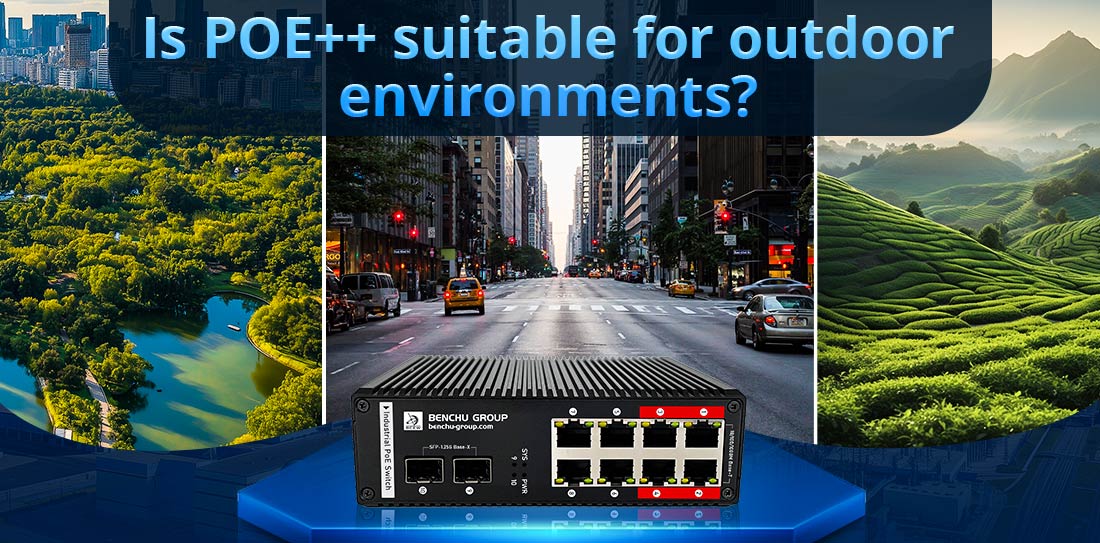
Yes, PoE++ (Power over Ethernet 802.3bt) is suitable for outdoor environments, but specific considerations are needed to ensure optimal performance and durability. PoE++ switches provide robust power levels (up to 100 watts per port), which is beneficial for outdoor applications where devices may require significant power for functionality and resilience in challenging conditions. Here are the factors that make PoE++ suitable and the precautions to consider for outdoor deployment.
Why PoE++ is Suitable for Outdoor Environments
1. High Power for Power-Hungry Outdoor Devices
--- Outdoor Security Cameras: Many outdoor surveillance cameras, especially high-resolution PTZ cameras with infrared (IR) for night vision, require high power. PoE++ can provide up to 100 watts per port, which is sufficient for cameras with multiple features, such as tilt, zoom, heating, and cooling elements.
--- Outdoor Wireless Access Points (WAPs): High-performance WAPs that extend Wi-Fi coverage in outdoor areas, like campuses, parks, or stadiums, often require additional power to operate at peak performance in various weather conditions. PoE++ ensures these devices receive reliable power without separate cabling for power.
--- Digital Signage and LED Lighting: Outdoor digital displays for advertising or information and LED lighting systems in smart city applications often draw substantial power, which PoE++ can provide effectively.
2.Simplified Infrastructure and Installation
--- Single-Cable Solution: In outdoor settings, reducing the number of cables needed is essential for streamlining installation and minimizing exposed wiring. PoE++ enables power and data to be transmitted over a single Ethernet cable, reducing cabling complexity and improving installation aesthetics.
--- Remote Management: PoE++ allows outdoor devices to be powered and managed from a central switch or controller indoors, simplifying maintenance and monitoring. Power can be remotely cycled or adjusted if a device needs troubleshooting, which is especially advantageous for devices installed in hard-to-access areas.
Key Considerations for Using PoE++ in Outdoor Environments
1. Weatherproofing and Enclosures
--- Outdoor-Rated Enclosures: PoE++ switches themselves are typically not designed for direct outdoor exposure. However, they can be placed in weatherproof, outdoor-rated enclosures to protect them from moisture, dust, temperature fluctuations, and physical damage.
--- Ingress Protection (IP) Rating: For outdoor-powered devices, select models with a high IP rating, such as IP65 or IP67, which ensures the device is well-protected from water and dust.
2. Temperature Tolerance
--- Temperature-Resilient Devices: Outdoor environments can expose equipment to temperature extremes, from very cold to very hot. PoE++ devices and switches should be rated for a broad temperature range to ensure reliable performance. Industrial-grade PoE++ switches and equipment are often designed to operate in extreme temperatures, making them suitable for outdoor environments.
--- PoE++ Cable Insulation: Choosing outdoor-rated Ethernet cables (like Cat6a or Cat7) with weather-resistant insulation ensures long-term durability and protection against temperature extremes, UV exposure, and moisture.
3. Cable Length and Signal Integrity
--- Maximum Transmission Distance: PoE++ supports up to 100 meters (328 feet) per cable run, which is often sufficient for outdoor applications. However, to maintain power and signal integrity, ensure high-quality cabling (Cat6a or higher) and avoid unnecessary extension beyond the 100-meter limit.
--- Power Loss in Cables: To minimize power loss in outdoor runs, it’s crucial to use high-quality Ethernet cabling that is specifically rated for outdoor PoE applications. Outdoor cables with gel-filled cores, for instance, are more resistant to moisture.
4. Lighting Protection and Grounding
--- Surge Protection: Outdoor PoE++ setups are vulnerable to electrical surges from lightning strikes or power fluctuations. Installing surge protectors or lightning arrestors between outdoor devices and the PoE++ switch can protect both the equipment and the network infrastructure.
--- Proper Grounding: Grounding outdoor devices and cabling according to local standards and PoE equipment recommendations can further protect against damage from surges.
5. PoE Extenders for Extended Range
--- Using PoE Extenders: For setups where devices need to be placed farther than the standard 100-meter Ethernet limit, PoE extenders can be used to increase the range. However, each extender reduces the amount of power available to the end device, so this should be carefully planned based on the power requirements of the connected devices.
Common Outdoor Applications for PoE++
Smart City Infrastructure: PoE++ powers streetlights, environmental sensors, and digital signage across cities.
Outdoor Surveillance: Advanced security cameras and monitoring equipment benefit from PoE++ to operate seamlessly in various weather conditions.
Public Wi-Fi: Outdoor wireless access points for parks, campuses, and public areas often need higher power levels provided by PoE++.
Agricultural and Environmental Monitoring: IoT devices like soil sensors, weather stations, and irrigation controls are frequently deployed in outdoor environments and powered via PoE++ for remote data collection and control.
Summary
PoE++ is highly suitable for outdoor environments due to its high power output and ability to simplify infrastructure, powering a range of outdoor devices from a central location. With careful attention to enclosures, cabling, surge protection, and environmental ratings, PoE++ can reliably support power-hungry devices in challenging outdoor settings. This makes it an essential tool for applications that require both high power and reliable network connectivity.